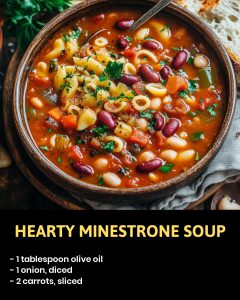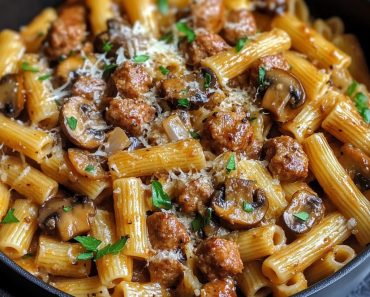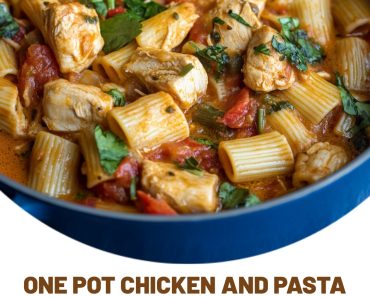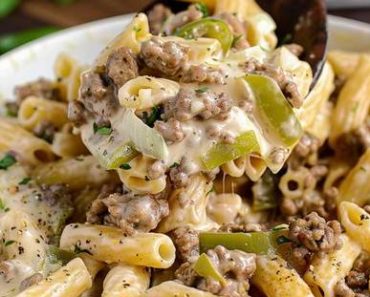
Hearty and Comforting Minestrone Soup Recipe
Cozy up with a warm bowl of Hearty Minestrone Soup—a classic Italian dish that brings together vibrant, nourishing vegetables, tender pasta, and fragrant herbs in a rich broth. This soup is perfect for relaxing evenings, shared family meals, or as a make-ahead meal for busy weeks. Easy to make, versatile, and incredibly satisfying, this recipe will quickly become a staple in your kitchen. Let’s dive into a beautiful culinary journey that celebrates simplicity, comfort, and flavor.
Ingredients Overview
Each ingredient in this Minestrone soup adds depth, warmth, and a splash of color. Here’s a breakdown of what makes this soup so delightful:
- Olive Oil (1 tablespoon): Adds a smooth, subtle richness while helping the vegetables soften and release their flavors.
- Onion (1, diced): The backbone of flavor; onions provide a sweet-savory base that enhances every bite.
- Carrots (2, sliced): Sweet, earthy, and colorful, carrots add texture and a hint of sweetness.
- Celery (2 stalks, diced): Known for its subtle peppery flavor, celery adds a delightful crunch and an aromatic touch.
- Garlic (3 cloves, minced): Bold and aromatic, garlic infuses the broth with depth and richness.
- Diced Tomatoes (1 can): Tangy, juicy, and slightly acidic, canned tomatoes bring a beautiful balance to the broth.
- Kidney Beans (1 can, drained and rinsed): Protein-packed beans add heartiness and a creamy texture to each spoonful.
- Vegetable Broth (4 cups): The foundation of the soup, vegetable broth ties everything together with a light yet savory taste.
- Dried Basil & Oregano (1 teaspoon each): Classic Italian herbs that lend warmth, fragrance, and a hint of sweetness.
- Pasta Shells (1 cup): These small shells soak up the broth, becoming tender and flavorful.
- Salt & Pepper: To enhance and balance all the flavors.
- Fresh Parsley (for garnish): Adds a vibrant green pop of color and fresh herbaceous notes.
Step-by-Step Cooking Instructions
Step 1: Heat the Olive Oil
In a large, heavy-bottomed pot, warm 1 tablespoon of olive oil over medium heat. The gentle heat allows the oil to become fragrant, setting the stage for the vegetables.
Step 2: Sauté the Vegetables
Add the diced onion, sliced carrots, diced celery, and minced garlic to the pot. Stir occasionally, cooking for about 5–7 minutes, or until the vegetables become tender and aromatic. The onions should look translucent, while the carrots and celery soften and absorb the fragrant garlic.
Step 3: Add Tomatoes, Beans, and Broth
Pour in the diced tomatoes, kidney beans, and vegetable broth. Sprinkle in the dried basil and oregano. Stir well to combine. Increase the heat slightly to bring the mixture to a gentle simmer, allowing the flavors to meld beautifully.
Step 4: Incorporate the Pasta
Add the pasta shells to the simmering soup. Let them cook in the broth, stirring occasionally, until they’re tender—usually about 10–12 minutes. The pasta will absorb some of the flavorful broth, adding a hearty texture to the soup.
Step 5: Season and Serve
Once the pasta is perfectly cooked, season the soup with salt and pepper to taste. Serve hot, garnished with a sprinkle of fresh parsley for an added burst of color and freshness.
Valuable Tips for a Seamless Cooking Experience
Tip 1: For extra depth, add a Parmesan rind while simmering the soup and remove it before serving.
Tip 2: Use low-sodium broth if you want to control the salt levels.
Tip 3: Sauté the vegetables for a few extra minutes to get a caramelized flavor.
Tip 4: For added creaminess, puree a small portion of the soup and mix it back in.
Tip 5: Add a pinch of red pepper flakes for a gentle kick.
Tip 6: For richer flavor, replace half the vegetable broth with tomato juice.
Tip 7: Substitute pasta with small diced potatoes for a gluten-free version.
Tip 8: Add spinach or kale at the end for extra greens.
Tip 9: Freeze any leftover soup without the pasta to maintain texture.
Tip 10: Add a splash of balsamic vinegar at the end for a sweet-tangy touch.
Tip 11: Sauté some fresh rosemary or thyme with the vegetables for added flavor.
Tip 12: To make it heartier, add diced zucchini or yellow squash.
Tip 13: Consider using fire-roasted tomatoes for a smoky flavor.
Tip 14: Cook the pasta separately if you plan to freeze or store leftovers.
Tip 15: Top each serving with a dollop of pesto for a burst of basil flavor.
Tip 16: Drizzle a little extra virgin olive oil before serving for richness.
Tip 17: Use a mix of beans for a more varied texture and flavor.
Tip 18: For more depth, add a splash of white wine when cooking the vegetables.
Tip 19: Try whole-grain pasta for a healthier option.
Tip 20: Make it spicy with a few drops of hot sauce in the broth.
Storage and Reheating Tips
- Storage: Transfer any cooled leftover soup to an airtight container. It can be stored in the refrigerator for up to 4–5 days.
- Freezing: Freeze the soup without pasta for best results. The soup base will last up to 2–3 months in the freezer.
- Reheating: To reheat, simply warm the soup on the stovetop over medium heat until hot, or use the microwave. Add a splash of water or broth if it’s too thick after refrigerating.
Frequently Asked Questions
Q1: Can I use fresh herbs instead of dried?
A1: Yes! Substitute with 1 tablespoon each of fresh basil and oregano for a vibrant flavor.
Q2: How can I make this soup thicker?
A2: Mash some of the beans or add a potato and blend a portion of the soup for a thicker texture.
Q3: Is there a way to make this soup gluten-free?
A3: Absolutely! Replace the pasta with gluten-free noodles or add potatoes.
Q4: Can I use chicken broth instead?
A4: Yes, chicken broth works well for a slightly richer flavor.
Q5: What other vegetables can I add?
A5: Zucchini, spinach, kale, or bell peppers make great additions.
Q6: Can I make this in a slow cooker?
A6: Yes, cook on low for 6–8 hours, adding pasta 20 minutes before serving.
Q7: How do I prevent the pasta from getting mushy?
A7: Cook the pasta separately and add it just before serving.
Q8: Can I use fresh tomatoes instead of canned?
A8: Absolutely. Use about 4–5 fresh tomatoes, chopped.
Q9: How can I make this soup spicy?
A9: Add red pepper flakes or a diced jalapeño to the vegetable sauté.
Q10: Can I add meat to this soup?
A10: Yes, cooked sausage or ground turkey would complement it well.
Q11: What other beans can I use?
A11: Try cannellini beans, black beans, or chickpeas.
Q12: Can I use frozen vegetables?
A12: Yes, they’re a quick and convenient addition.
Q13: Can I omit the pasta altogether?
A13: Yes! Replace it with quinoa or extra beans.
Q14: What can I do if my soup is too salty?
A14: Add a potato or a splash of lemon juice to balance the saltiness.
Q15: How can I enhance the broth flavor?
A15: Try a dash of soy sauce or Worcestershire sauce for umami depth.
Q16: Can I add milk or cream for a creamy texture?
A16: Yes, stir in a splash of cream or milk at the end.
Q17: What can I use instead of olive oil?
A17: Vegetable or avocado oil is a fine substitute.
Q18: How can I make the soup taste fresher?
A18: Add fresh lemon zest or juice just before serving.
Q19: Can I use a pressure cooker?
A19: Yes, cook on high for 10 minutes, then quick release.
Q20: How can I add a smoky flavor?
A20: Add smoked paprika or fire-roasted tomatoes to the soup.
With these tips, answers, and secrets, this Hearty Minestrone Soup becomes a versatile and effortless recipe perfect for any season




















